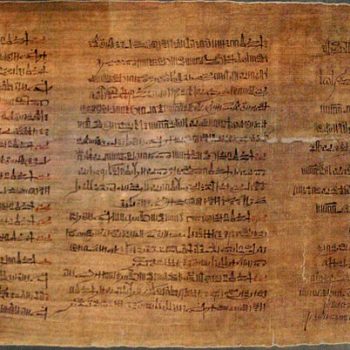Searching for Lost Tombs at the British Museum

The Abbot Papyrus (BM EA 10221), which tells the story of the tomb inspections that occurred at the end of the New Kingdom. Now located at the British Museum. ©Captmondo, Wikimedia Commons.
Last week, the British Museum held an evening event featuring established Egyptologist, Chris Naunton speaking about his latest book, Searching for the Lost Tombs of Egypt. The book covers ancient Egyptian mysteries from the Old Kingdom right down to the Ptolemaic period.
Naunton’s talk focused on the answering the one question everyone asks him: Is there anything left to find in Egypt? Naunton’s answer was an emphatic YES! There has been plenty of new material coming out of Egypt over the past few years. Some incredibly exciting finds, such as the mysterious black sarcophagus that was unearthed in July of last year, turned out not to be cursed, or Alexander the Great’s final resting place, but the grave of three soldiers.
What prompted Naunton to write the book? In addition to debunking the myth that there was no more left to discover in Egypt, he was curious about all the lost tombs that haven't yet been found, and decided to see if he could continue where others had left off. This train of thought resulted in his most recent endeavour – to try and fill in these ‘conspicuous gaps’. He discovered that there were many missing tombs, especially during the Intermediate periods, due to political instability and uncertainty. He talked about the earlier archaeologists who were also intrigued by these missing tombs. Their theories informed his, and propelled his research for the book forward.
Naunton obviously couldn’t cover every missing tomb in this talk, so he briefly touched on the more well-known historic figures, such as Imhotep, Amenhotep I, Nefertiti, Alexander the Great, Cleopatra, and and the 26th Dynasty tombs that were described by ancient Greek historian, Herodotus.
The last part of the talk focused on bridging the gap between the audience and museum. Naunton shared what visitors to the British Museum can find concerning lost tombs. The Abbot Papyrus (BM EA 10221), is one such item. It was bought from Henry Abbot in the middle of the nineteenth century and tells the story of a series of tomb inspections at the end of the New Kingdom, (during the rule of Ramses IX). It describes nine tombs, from pharaohs of the 11th Dynasty, 17th Dynasty, and Amenhotep I (18th Dynasty). The location of several of these tombs is known. Inteff II, and Mentuhotep II (at the site of Deir el-Bahri). He also directed visitors to the statue of Amenhotep I (BM EA 683) in the sculpture gallery, and to look at gallery 63: Nubkheperre Intef VI? (BM EA 6652). There is some debate if it is indeed Intef VI, or III.
Naunton is fascinated by archaeology because it allows one the ability to see things ‘in place’ – in the context of where they were last left thousands of years ago. He continues to be captivated by the human presence in these historic finds and objects, by the idea of crossing time, and narrowing the gap between the past and the present. We are thrilled to announce that Chris Naunton will be featured in an upcoming issue of Ancient History Magazine!
Visit Chris Naunton’s website: www.chrisnaunton.com
Buy his book: Searching for the Lost Tombs of Egypt
Follow Chris Naunton on Twitter: @chrisnaunton
Interested in finding out more about ancient Egypt?
